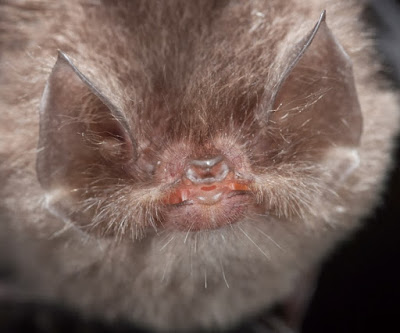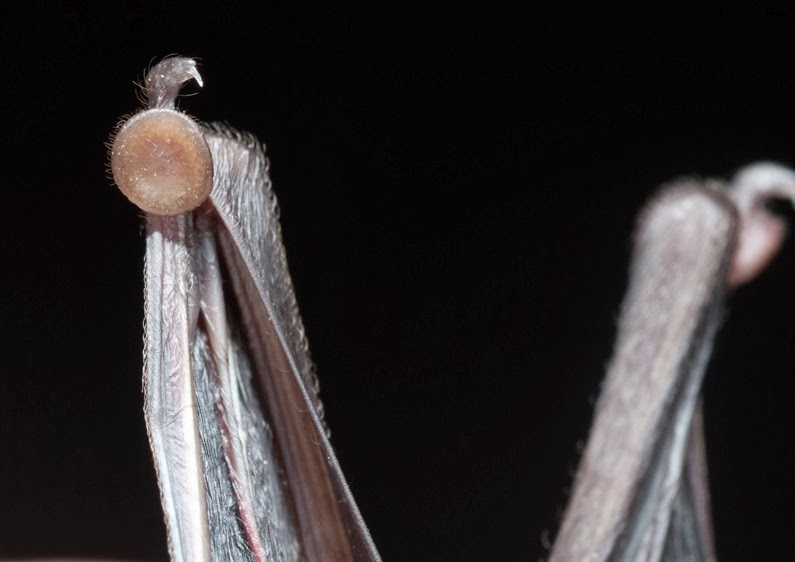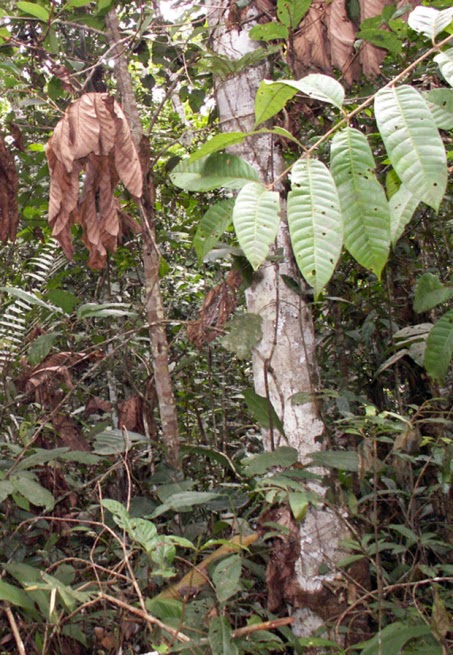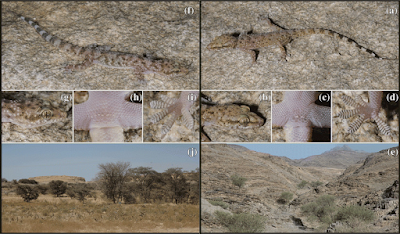[Most Recent Entries] [Calendar View]
Wednesday, November 30th, 2016
| Time | Event | ||||
| 1:41a | [Ichthyology • 2016] Oreonectes daqikongensis • A New Blind Species of the Cave Genus Oreonectes (Balitoridae: Nemacheilinae) from Guizhou, China
Abstract This study aimed to describe a new specimen of cavefish collected from a karst cave in the Daqikong area of Libo County, Guizhou. Twenty-six cavefish specimens were collected and identified as a new species of Balitoridae: Nemacheilinae, and named Oreonectes daqikongensis sp. n. A genetic analysis was performed and showed that its genetic distances from Oreonectes shuilongensis and Oreonectes platycephalus are higher than intraspecific distances. Discovery of this species will be helpful to understand the distribution of Oreonectes. Keywords: Cavefish, Libo, new species, Oreonectes daqikongensis sp. n.
Diagnosis: The species has a large head, and the width of the head is larger than its depth. The frontal torso is nearly cylindrical, the backend gradually compresses, and the head is slightly flattened. There is a short distance between the anterior and posterior nostrils, and the anterior nostril forms a short and tubular structure, which is truncated backward. The pectoral fin extends backward to or beyond the starting point of the pelvic fin. The body is naked. The eyes are completely degraded; and eye socket was filled in fat tissue and without any outside remnant indicating their presence. The superior and inferior caudal peduncles have well-developed soft finfolds. No carneous fin flaps are present in the pelvic fin axilla. The air bladder is wrapped in a bony capsule, and the posterior chamber of the air bladder is developed into a membranous chamber, which is separated from the abdominal cavity and connected to the anterior chamber by a short duct. The whole body is white and transparent, when they are alive, they look a little red because the blood inside, and is unlikely to become black when it is fed in sunlight for a long term. Habitat: This species was found only in the Daqikong scenic area. The opening of the cave was halfway up the mountain, and the distance from the opening to the pool was about 15–20 m. The cave got no sunshine because of the twisty pathway. A large number of Hipposideros armiger lived in the cave and a thick layer of bat dung was found on the ground. Groundwater extended into the cave, and the water rushed outside the cave in the case of heavy rain. So far, no other fish, shrimps, or aquatic animals were found in the cave. The subterranean river belonged to the Dagou river system, and was the main river of the Libo County, which runs through the whole county, enters Guangxi from the Laocun Xiang, and was the major tributary of the Duliu River system (Figure 2). Huaiqing Deng, Huamei Wen, Ning Xiao and Jiang Zhou. 2016. A New Blind Species of the Cave Genus Oreonectes from Guizhou, China (Nemacheilinae). ZooKeys. 637: 47-59. DOI: 10.3897/zookeys.637.10202 | ||||
| 3:36p | [Ichthyology • 2016] Revision of the South American Genus Tetragonopterus Cuvier, 1816 (Teleostei: Characidae) with Description of Four New Species
Abstract The systematics of the characid genus Tetragonopterus is reviewed based on morphological and molecular data of specimens from its entire geographical range encompassing all major South American river drainages from Orinoco basin southward to the La Plata basin. Eight previously described species (T. anostomus, T. araguaiensis, T. argenteus, T. carvalhoi, T. chalceus, T. denticulatus, T. georgiae n. comb., and T. rarus) are recognized as valid, four of which are redescribed (T. argenteus, T. chalceus, T. georgiae, and T. rarus), and four new species from the Brazilian Shield in the Amazon and São Francisco river basins are herein described. We also provide evidence for the reallocation of Moenkhausia georgiae into Tetragonopterus and recognize T. akamai as junior synonym of T. anostomus. DNA barcodes of Tetragonopterus revealed genetic support for each recognized species and provided valuable population-level information within T. argenteus, T. chalceus, T. georgiae, and T. rarus. Keywords: Pisces, Amazon basin, Characiformes, DNA barcode, Moenkhausia, Neotropical region Silva, Gabriel S. C., Bruno F. Melo, Claudio Oliveira and Ricardo C. Benine. 2016. Revision of the South American Genus Tetragonopterus Cuvier, 1816 (Teleostei: Characidae) with Description of Four New Species. Zootaxa. 4200(1); 1–46. DOI: 10.11646/zootaxa.4200.1.1 | ||||
| 3:44p | [Mammalogy • 2014] Thyroptera wynneae • Extraordinary Local Diversity of Disk-Winged Bats (Thyropteridae: Thyroptera) in Northeastern Peru, with the Description of a New Species and Comments on Roosting Behavior
ABSTRACT Species of Thyroptera are insectivorous foliage-roosting bats that inhabit lowland moist forests (including gallery formations in savanna landscapes) from Mexico to southeastern Brazil. Although four species are currently recognized, only one or two species were previously known to occur at most localities. Recent inventory work in northeastern Peru has documented the local cooccurrence of four species of Thyroptera, one of which is here described as new. The new species (Thyroptera wynneae), which also occurs in Brazil, can easily be recognized by a combination of diagnostic morphological traits. The latter include small size, tricolored ventral pelage, long and woolly hairs between the shoulders, a uropatagium with the proximal half densely covered by long hairs, wing tips sparsely covered by long hairs, a calcar with two lappets and five tiny skin projections between the foot disk and the proximal lappet, a rostrum considerably shorter than the braincase, third lower incisors that are subequal in height to the first and second lower incisors, and third lower incisors with two well-developed accessory cusps. We illustrate the crania of all five known species of Thyroptera and provide a key based on craniodental and external characters. Unexpectedly high local diversity of these elusive bats poses a challenge for future inventory research and raises interesting questions about ecological-niche partitioning in Neotropical bat communities and the evolutionary history of thyropterids. Paúl M. Velazco, Renato Gregorin, Robert S. Voss and Nancy B. Simmons. 2014. Extraordinary Local Diversity of Disk-Winged Bats (Thyropteridae: Thyroptera) in Northeastern Peru, with the Description of a New Species and Comments on Roosting Behavior. American Museum Novitates. 3795 :1-28. doi: 10.1206/3795.1 http://www.paulvelazco.com/uploads/8/3/7/7/8
How ‘biology’s Indiana Jones’ discovered a tiny, bizarre suction-cup bat in the western Amazon | ||||
| 4:15p | [Herpetology • 2013] Nototriton mime • A New Nototriton (Caudata: Plethodontidae) from Parque Nacional Montaña de Botaderos in northeastern Honduras
Abstract The highlands of northeastern Honduras remain under-characterized in terms of biological diversity, as exemplified by the regularity of new amphibian and reptile taxa discoveries. Following the recent description of a new species of Nototriton from the Sierra de Agalta in northeastern Honduras, we report the discovery of a second new species of Nototriton from the nearby Parque Nacional Montaña de Botaderos. This new taxon, Nototriton mime sp. nov., is distinguished from other Nototriton by its distinctive pale brown dorsal coloration in adult males, relatively large nares, a relatively broad head, mitochondrial sequence divergence, and phylogenetic relationships, and is geographically isolated from other populations of Nototriton. Keywords: Nototriton mime sp. nov., mtDNA, 16S, cytochrome b, Nototriton picucha, sexual dichromatism Etymology. The specific epithet “mime” is a noun in apposition to the generic name, given to honor our late friend Arquimides Gabriel Rosales Martinez, or “Mime” (pronounced me-may), a young Honduran biologist passionate about amphibians. Mime and his sister, Novy Hortensia Rosales Martinez, were killed by a drunken driver on 17 December 2010 in Tegucigalpa. Natural history: The habitat at the type locality is tropical montane cloud forest, in the Lower Montane Wet Forest formation. The male holotype (USNM 579870; Fig. 3A) was active at night among the leaves of an orchid growing on a small stump on the ground along a wet ridge at 1,705 m elevation. The male paratype (USNM579871; Fig. 3C) was collected from underneath a small log embedded in the ground at 1,720 m elevation. The female paratype (MVZ 269306; Fig. 3B) was found in a bromeliad on the ground at 1,705 m elevation, near the holotype. The juvenile paratype (USNM 579872; Fig. 3D) was collected during the late afternoon from within a small bromeliad approximately 2 m above the ground on a large fallen branch at 1,710 m elevation. Remarks. With the description of Nototriton mime, there are 17 named species of Nototriton distributed from Guatemala to Costa Rica, six of which are endemic to Honduras (Townsend et al. 2011; Boza-Oviedo et al. 2012).Each of these six endemic species have distributions restricted to cloud forest habitat in the upper reaches of isolated mountain ranges, with only one species (N. limnospectator) known to occur at premontane elevations aslow as 800 m. In addition to these six species, there are two as yet undescribed species currently referred to the taxon N. barbouri , one from Parque Nacional Pico Bonito (N. sp A in Townsend et al. 2011) and one from Refugiode Vida Silvestre Texíguat (N. sp. B, op. cit.). The coloration seen in Nototriton mime appears to be the first documented case of sexual dichromatism in thegenus Nototriton, and one of few documented cases in tropical salamanders. Another endemic Honduras salamander, Bolitoglossa diaphora, from the Sierra de Omoa in northwestern Honduras, also exhibits marked dichromatism, with males being bluish-gray and females being a mottled red-orange coloration (McCranie &Wilson 1995). Townsend, Josiah H., Melissa Medina-Flores, Onán Reyes-Calderón & James D. Austin. 2013. A New Nototriton (Caudata: Plethodontidae) from Parque Nacional Montaña de Botaderos in northeastern Honduras. Zootaxa. 3666(3): 358–368. DOI: 10.11646/zootaxa.3666.3.6 | ||||
| 4:38p | [Crustacea • 2016] Geosesarma batak & G. tagbanua • Two New Species of Geosesarma De Man, 1892 (Brachyura: Sesarmidae) from Palawan, the Philippines
Abstract Two new and relatively large species of semi-terrestrial sesarmid crabs of the genus Geosesarma De Man, 1892, are described from Palawan Island, Philippines. They are distinguishable from congeners by the characteristic structure of their carapace, chelipeds, ambulatory legs and male first gonopods. Aspects of their ecology are briefly discussed. Key words: Crustacea, Brachyura, Decapoda, Sesarmidae, Geosesarma, Palawan, Philippines, taxonomy, new species
Marivene Manuel-Santos, Peter K. L. Ng and Hendrik Freitag. 2016. Two New Species of Geosesarma De Man, 1892 (Crustacea: Brachyura: Sesarmidae) from Palawan, the Philippines. RAFFLES BULLETIN OF ZOOLOGY. 64: 335–342 | ||||
| 4:49p | [Herpetology • 2017] Endemic Diversification in the Mountains: Genetic, Morphological, and Geographical Differentiation of the Hemidactylus Geckos in southwestern Arabia
Abstract In this study, we provide genetic, morphological, and geographical comparisons for 11 species of the southwestern Arabian radiation of Hemidactylus geckos, nine of which are endemic to the region. By using a coalescence-based species-tree reconstruction in combination with divergence time estimations and speciation probability testing, we show that most of the speciation events occurred in the Pliocene, which is more recent than previously thought based on calibrations of concatenated data sets. The current dating indicates that the changing climate at the beginning of the Pliocene, from hot and dry to cold and wet, is likely responsible for increased speciation in Hemidactylus. Analyses of geographic and altitudinal overlap of the species and their morphological differentiation show that most species do not occur in sympatry. Those that overlap geographically are usually differentiated by their altitudinal preference, head shape, body size, or their combination. Our results indicate that the topographically complex mountains of southwestern Arabia support a significant radiation of Hemidactylus geckos by allowing multiple allopatric speciation events to occur in a relatively small area. Consequently, we describe two new species endemic to the Asir Mountains of Saudi Arabia, H. alfarraji sp. n. and H. asirensis sp. n., and elevate two former subspecies of H. yerburii to a species level, H. montanus and H. pauciporosus. Keywords: Allopatry; Diversity; Gekkonidae; Radiation; Species delimitation; Species tree; Speciation Jiří Šmíd, Mohammed Shobrak, Thomas M. Wilms, Ulrich Joger and Salvador Carranza. 2016. Endemic Diversification in the Mountains: Genetic, Morphological, and Geographical Differentiation of the Hemidactylus Geckos in southwestern Arabia. Organisms Diversity & Evolution. DOI: 10.1007/s13127-016-0293-3 |
| << Previous Day |
2016/11/30 [Calendar] |
Next Day >> |

















